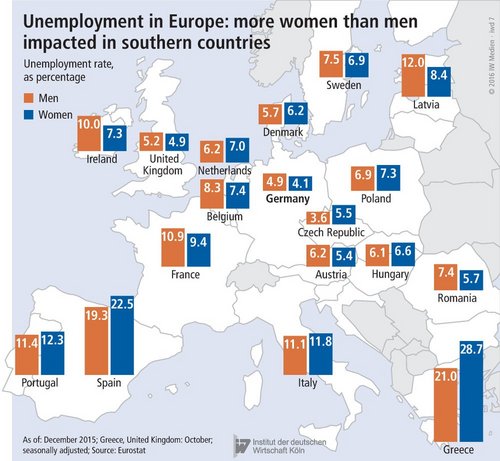Unemployment often has a stronger impact on women than men, especially in southern Europe. Yet the situation gradually seems to be turning around, in spite of the euro and economic crisis. And in traditional industrialised countries such as Germany, women are the clear winners in the employment upturn.
Unemployment: Two of every three new jobs go to women
The gender gap in unemployment in the EU-28 is not obvious at first glance. In December 2015, an average of 9.0 per cent of men and 9.1 per cent of women in the EU were unemployed.
However, considerable differences can be seen between the individual member countries. Unemployment is significantly higher for women than men in southern European countries, where joblessness is a major concern, particularly in Greece and Spain (see chart). However, in countries with a low unemployment rate, such as Austria, the United Kingdom and Germany, women are less likely than men to be jobless.
In nearly every EU country, gender-specific unemployment rates have been shifting in favour of women since the global economic crisis began in 2009.
In Greece unemployment among women was 2.5 times as high as among men ten years ago; today, it is one-fourth again as high.
In France half again as many women as men were unemployed in 2001; in 2015, women were less likely to be jobless than men.
Job opportunities have clearly improved for women in Europe, even if there is some catching up to be done in the southern countries. This better performance lies largely in their occupational choices. Many women work in service industries, such as healthcare or education, that are not particularly vulnerable to economic fluctuations. In contrast, men are often employed in industry, which is highly sensitive to the health of the economy.
Even if Germany’s industrial sector is still going strong, the country cannot fail to recognise the strong trend towards a services economy. This is especially true in light of the many industrial companies now offering the corresponding services along with their products. And the refugee crisis has created a new demand for occupations that have a strong female representation, such as social workers and elementary school teachers.
The following two comparisons show how structural change is putting the employment market into a spin:
- Between 2001 and 2015, a good 600,000 industrial jobs in Germany were eliminated for men, and an equal number for women.
- At the same time, 1.6 million new jobs were created in the education, healthcare and social services sector – with more than 1.2 million of them going to women.
Of all of the jobs created between 2001 and 2015, 64 per cent have gone to women.

Arbeitszeit: Sind die Deutschen arbeitsscheu?
Ob in Deutschland mehr oder weniger als in anderen Ländern gearbeitet wird, lässt sich aus der Anzahl der geleisteten Arbeitsstunden je Erwerbstätigen nicht ablesen. Auch wenn zusätzlich die Erwerbsbeteiligung berücksichtigt wird, erweist sich der Grad der ...
IW
Fachkräftemangel: „Es gibt mehr Parameter als nur die Arbeitszeit, um den Arbeitsplatz attraktiv zu machen“
Könnte eine Vier-Tage-Woche den Fachkräftemangel in Deutschland mildern? Im Handelsblatt-Podcast „Economic Challenges“ diskutieren IW-Direktor Michael Hüther und HRI-Präsident Bert Rürup, warum mehr als nur verkürzte Arbeitszeiten nötig sind, um die ...
IW
